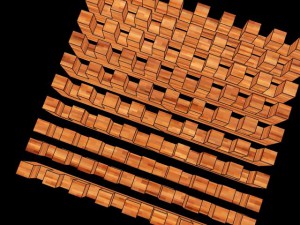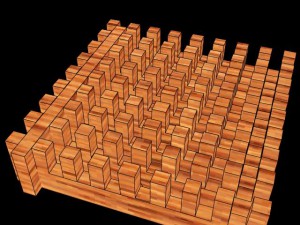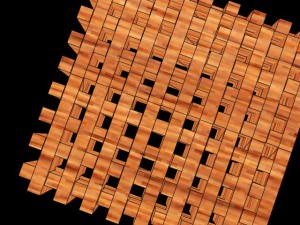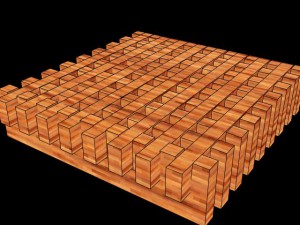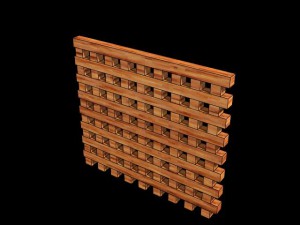前回#4(6月11日投稿)の続きです。
第5回目は、グレーチング(格子)です。
堀会員製作
8.甲板上の艤装小物
An equipment of a ship accessory on the deck
グレーティング(格子)加工 grating processing
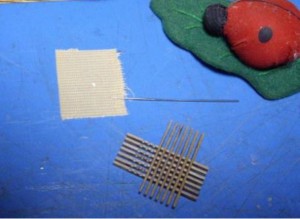 1.パーツの格子を組合せる。
1.パーツの格子を組合せる。
瞬間接着剤を使用する際、接着剤をガムテープに小出しし(不思議と固まりません)、スノコの組合せ部分に針を使用して
少量の接着剤を付け、不要部分をカット、ペーパーで側面を面一に加工します。
1.I put the grating of the part together.
I do a small amount of superglue to packing tape not to harden during work. Then I do not harden during work.
I attach a little adhesive to the combination part of the gratingboard with a needle.
I cut an unnecessary part and machine the side to one aspect with sandpaper.
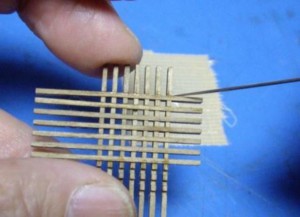 2.スノコを枠に貼り合せる。
2.スノコを枠に貼り合せる。
格子の方向に注意! 船首・船尾方法を縦木にします。
2.I affix a gratingboard to a frame.
I am careful to the courses of the grating!
A tree long becomes the bow / the stern method.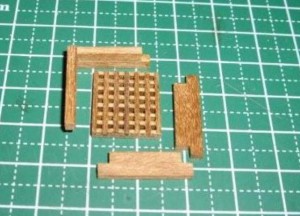
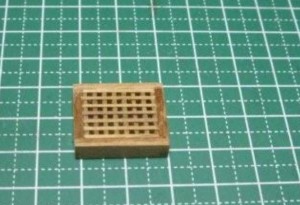 3.キャンバーに合せて加工する。
3.キャンバーに合せて加工する。
直線のままだと見栄えがしないので、是非ともアール加工を。
3.I process it to a camber.
Because I am not attractive when it is a straight line, I do are processing by all means.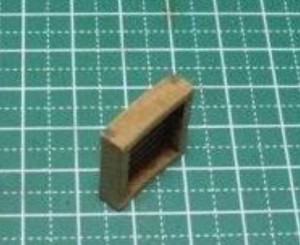
#6に続きます。階段の加工です。
<格子の作り方のいろいろ>
格子の加工方法は大きく4種あります。
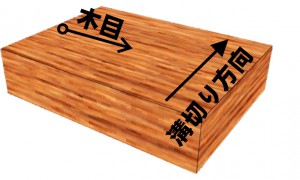 必ず木目に直角に溝を切ります。
必ず木目に直角に溝を切ります。
(後でスライスカットする時に凸が飛ばないためです。)
I cut a ditch in a right angle in a grain of wood by all means.
(the reason is because a convex is not blown off when I will slice it later and cut it.)
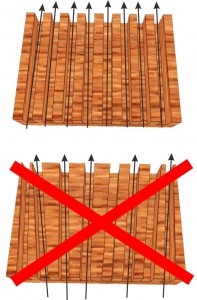 溝は必ず平行でないと駄目です。
溝は必ず平行でないと駄目です。
(組めなくなります。)
The ditch should be parallel by all means.
(I cannot cross it.)
溝の幅はカッターで決まってしまいます。
私は、御徒町のシーフォースで0.5mm幅のカッターを使っています。
カッタの厚さが載っていませんが
Busch231 17ページ下に厚さ等寸法が載っています。 他にミニター社のカッターもあります。
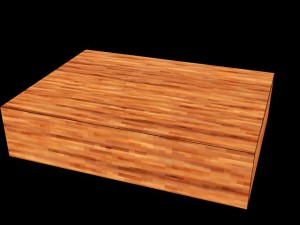 The breadth of the ditch is fixed with a cutter.
The breadth of the ditch is fixed with a cutter.
I use the 0.5mm cutter by sea force in Okachimachi.
There is the cutter of a thing of a MINITA tool elsewhere, too.
溝の幅と同じか若干狭い幅でスライスします。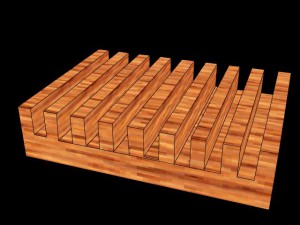
I am the same as the width of the ditch or slice it by narrow width slightly.
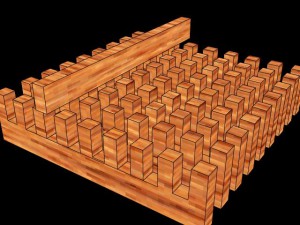 後半を櫛同士を組むのではなく、溝の幅と同じ縦木を入れても組めます
後半を櫛同士を組むのではなく、溝の幅と同じ縦木を入れても組めます
I do not cross combs
I can cross it even if I put a length tree same as the width of the ditch
どちらの方法も手間ですが、0.5mmの凸(1mmピッチ)まで加工できます。
ただ、ヒノキやブナでは櫛が悲しくなるくらい飛びますので、桜、柘植、ウォルナット、黒檀などの硬い木が必要です。
Both methods are trouble, but can process it to convex (1mm pace) of 0.5mm.
But firm trees such as a cherry tree, a Boxwood, a walnut, the ebony are necessary so that a comb teeth are missing so mauch with a hinoki-cypress or the beech.
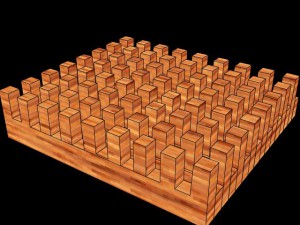 海外の本には、こちらの加工方法も紹介されています。
海外の本には、こちらの加工方法も紹介されています。
木目と直角に溝を入れた後、直角に溝を入れていきます。
The processing method of this place is introduced to an overseas book, too.
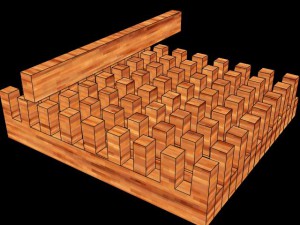 I groove a right angle after having grooved a grain of wood and a right angle.
I groove a right angle after having grooved a grain of wood and a right angle.
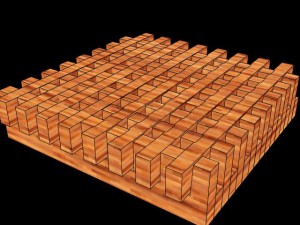
溝幅の縦木を接着し、底面をサンドペーパーやディスクサンダーで削り取ってしまうという方法です。
I glue a tree of the ditch width long together, and it is a method to scrape off 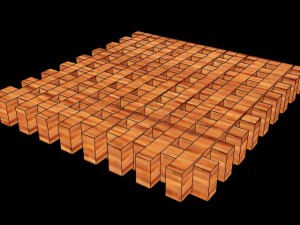 a base with sandpaper and a disk sander.
a base with sandpaper and a disk sander.
実は先の2法では溝幅に正確にかつ櫛が飛ばない様にスライスせねばなりませんが、これが難しいのです。
この方法ではスライスはしませんので楽です。
海外では柘植を使って0.5mm幅に加工していますが、桜等では1mm幅より狭いと直角に溝切りするときに凸が飛びます。
In fact, you must slice it so that and a comb does not fly in ditch width by 2 former law precisely, but this is difficult.
I machine it in 0.5mm width abroad with boxwood, but a convex chips when I cut a ditch in a right angle if smaller than 1mm width and do it with the cherry trees.
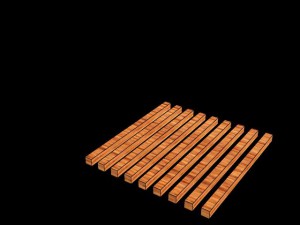 最後の方法も海外で示されていますが、チョッとお勧めです。
最後の方法も海外で示されていますが、チョッとお勧めです。
The last method is shown abroad, too, but it is cho and recommendation.
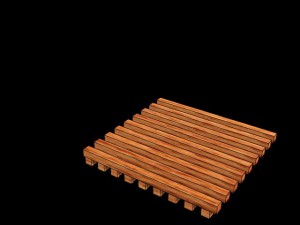 特別な道具もいりませんし、ヒノキでも加工できます。
特別な道具もいりませんし、ヒノキでも加工できます。
It does not need the special tool and can process even a Hinoki-cypress.
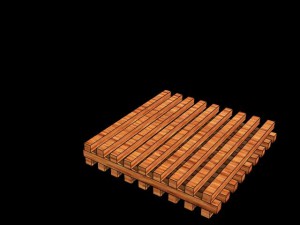 だいたい1.5mm以上の凸(3mmピッチ以上)だと簡単にできます。
だいたい1.5mm以上の凸(3mmピッチ以上)だと簡単にできます。
最後のスライスは中屋の組子用胴付鋸 替刃 0.2mm厚D210Cが切り口も綺麗でリーズナブルで便利です。
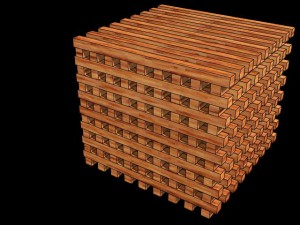 When it is convex more than about 1.5mm (more than 3mm pace), I can simplify it.
When it is convex more than about 1.5mm (more than 3mm pace), I can simplify it.
The cut end is clean, too, and saw spare blade 0.2mm thickness D210C with breastplate for members of a group of Nakaya is reasonable, and the last slice is convenient.
Eine Ausrüstung eines Schiffszubehöres für das Deck
das Knirschen von Verarbeitung
1. Ich setzte das Knirschen zusammen vom Teil.
Ich mache eine kleine Menge von superglue damit, Band zu packen, um sich nicht während der Arbeit zu härten. Dann härte ich mich nicht während der Arbeit.
Ich befestige zum Kombinationsteil des gratingboard mit einer Nadel ein wenig haftend.
Ich schnitt einen unnötigen Teil und stelle die Seite maschinell zu einem Aspekt mit Sandpapier her.
2. Ich bringe einen gratingboard zu einem Rahmen an.
Ich bin zu den Verläufen beim Knirschen vorsichtig!
Ein Baum wird lang der Bogen / die strenge Methode.
3. Ich verarbeite es zu einer Wölbung.
Weil ich nicht attraktiv bin, wenn es eine gerade Linie ist, mache ich, marschiert auf alle Fälle.
Die Verarbeitungsmethode von verschieden > das, wie zu machen ist, davon Knirschen < Gitter haben es von vier Arten sehr.
Ich schnitt auf alle Fälle in einen rechten Winkel in ein Korn des Holzes einen Graben.
(der Grund ist, weil ein konvexes nicht weggeblasen wird, wenn ich in Scheiben es später schneiden werde, und schnitt es.)
Der Graben sollte auf alle Fälle parallel sein.
(Ich kann es nicht überqueren.)
Die Breite des Grabens wird mit einem Messer in Ordnung gebracht.
Ich benutze das Messer von dieser Stelle um Meeresmacht von Okachimachi.
Es gibt auch woanders das Messer einer Sache eines Machtwerkzeuges.
Ich bin die Gleichen als die Weite des Grabens oder schneide in Scheiben es leicht durch schmale Weite.
Ich mache ein Gitter.
Ich überquere keine Kämme
Ich kann es überqueren, auch wenn ich als die Weite des Grabens gleich einen Längenbaum setzte
Beide Methoden sind Schwierigkeiten, aber können es zu von 0.5mm konvex (1mm Tempo) verarbeiten.
Aber feste Bäume wie ein Kirschenbaum, Buchbaum, eine Walnuß, das Ebenholz ist notwendig im Fliegen, damit ein Kamm mit einem hinoki und der Buche traurig wird.
Die Verarbeitungsmethode dieser Stelle wird auch mit einem Überseebuch bekanntgemacht.
Ich rille einen rechten Winkel, nachdem es ein Korn von Holz und einem rechten Winkel gerillt hat.
Ich klebe, ein Baum der Grabenweite sehnt sich zusammen, und es ist eine Methode, von einer Basis mit Sandpapier und einem Diskettenabschleifgerät zu kratzen.
In der Tat müssen Sie in Scheiben es schneiden damit und ein Kamm fliegt keine Grabenweite genau durch 2 ehemaliges Gesetz ein, aber dies ist schwierig.
Weil ich in Scheiben es nicht durch diese Methode schneide, bin ich bequem, außer ein konvexen Fliegen, als ich in einen rechten Winkel einen Graben schnitt, wenn kleiner als 1mm Weite und macht es.
Die letzte Methode wird auch im Ausland gezeigt, aber es ist cho und Empfehlung.
Es braucht das besondere Werkzeug nicht und kann sogar einen hinoki verarbeiten.
Wenn es mehr als ungefähr 1.5mm (mehr als 3mm Tempo) konvex ist, kann ich es vereinfachen.
Das Schnittende ist sauber, auch, und sah übriger Klingen-0.2mm-Dicke D210C mit Brustharnisch für Mitglieder bei einer Gruppe von Nakaya, ist vernünftig, und die letzte Scheibe ist zweckmäßig.
.

